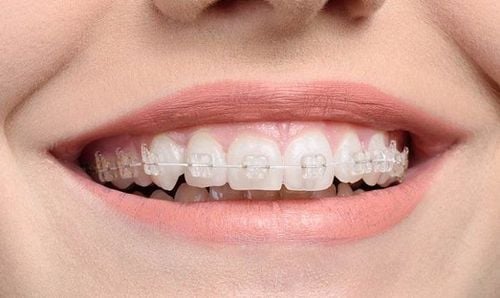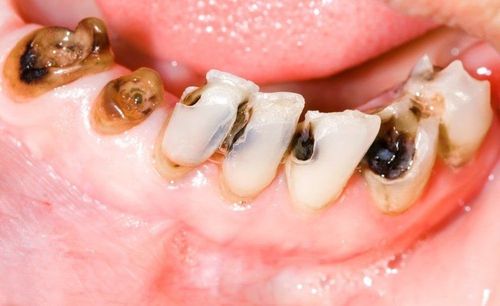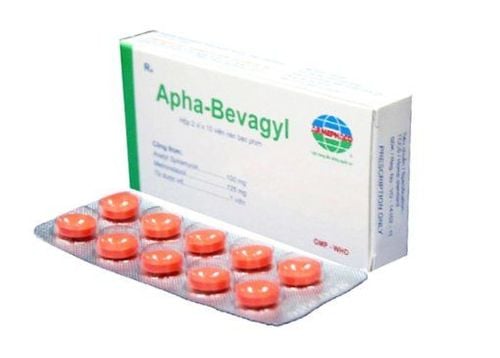This is an automatically translated article.
Oral hygiene is one of the most important steps for anyone, especially those with braces. Therefore, it is essential to use dental floss to reach and clean areas that ordinary toothbrushes can miss. However, is flossing with braces any different than usual?
1. The importance of oral hygiene when braces
Oral hygiene is an essential part of anyone's orthodontic treatment. If you ignore this job, food will tend to get stuck in and around your brackets, creating conditions for plaque accumulation and bacterial growth. This is a factor that promotes bacteria to react with sugar and starch in food, forming an acid that can erode tooth enamel, causing tooth decay.
Besides, when food accumulates around the braces for a long time, they will leave permanent stains on the teeth after removing the brackets. This is a calcification process and these stains are nearly impossible to treat.
In addition, periodontal disease is also an oral problem caused by the accumulation of plaque, including 3 stages:
Gingivitis : Plaque buildup irritates the gums around the teeth, leading to bleeding and swelling. . Periodontitis: Accumulated plaque hardens into tartar, creating gaps between the gums and teeth, causing more tartar to accumulate. The strong progression of periodontitis will form a pocket of bacteria, which will penetrate deep below the gums, attack and destroy the bones that fix your teeth, and at the same time make healthy teeth loose, even lead to to tooth loss. From the above issues, it can be seen that oral hygiene should be taken seriously, especially when performing orthodontic - braces.
2. Can braces be flossed? “Can braces be flossed?” the answer is yes and this is extremely necessary.
Flossing can make a lot of difference to anyone's oral health. In fact, no matter how thoroughly you brush your teeth, you can't completely clean your mouth. This is exactly why flossing is so important. For subjects with braces, the oral cavity will have more areas where food can get stuck.
When the right combination of brushing - enough and flossing, you will remove almost all food plaque in the mouth, prevent the growth of harmful bacteria and limit the risk of disease. about oral health, such as gingivitis, periodontitis, tooth decay...
Trắc nghiệm: Thử hiểu biết của bạn về răng
Răng là bộ phận quan trọng, giúp một người sử dụng miệng để ăn, nói, cười và tạo hình dạng cho khuôn mặt của họ. Tuy nhiên, có những sự thật thú vị về răng mà có thể bạn chưa từng biết. Hãy cùng trả lời nhanh 9 câu hỏi trắc nghiệm sau để thử hiểu biết của bạn về răng.
Bài dịch từ: webmd.com

You can take the following steps to clean your teeth.
Step 1 - Brush your teeth: First, brush your teeth to remove bacteria and food plaque on the tooth surface. Make sure the toothbrush reaches all surfaces of the teeth including the outer, inner, upper and flat surfaces of the upper/lower arches. Step 2 - Prepare the floss: Take a piece of floss about 30cm - 40cm long, wrap it around the tips of your index fingers. To avoid breaking the floss when using, you should use a thin but strong thread like superfloss with a thick sponge layer, which helps to clean teeth effectively. Step 3 - thread the floss into the teeth: Carefully and gently thread the floss between the teeth, paying attention to the thread around the roots. Next, move gently up and down along the length of the teeth, slowly removing the remaining plaque and food debris. Finally, remove the floss from between the existing teeth. Step 4 - repeat: Move the new floss to the other teeth and do the same things. Each action should be gentle and slow. Therefore, to ensure a thorough cleaning of all teeth, you need to spend an average of 10 to 15 minutes. This process requires great patience. 4. Issues surrounding flossing with braces How often do you floss?
Normally, plaque persists and hardens on teeth for about 24-36 hours. Therefore, you can floss every 24 hours to prevent the opportunity for plaque to harden, attracting bacteria to grow and develop.

How to use dental floss to limit damage to gums?
It is very important to floss along the gum line, but you need to be gentle, use moderate force when pulling the thread to move, to avoid bruising the gums.
Is there a solution other than flossing?
Some patients wonder if there are other time-saving methods than flossing. In it, there is a proposed solution that is a water flosser.
According to dental experts, water flosser is an effective solution to remove food particles from brackets, however, this solution cannot target the plaque buildup that causes tooth discoloration. Therefore, flossing is still the more recommended recommendation.
In general, flossing when braces can be difficult and time consuming, but this will ensure optimal oral hygiene and protect your oral health. friend.
Please dial HOTLINE for more information or register for an appointment HERE. Download MyVinmec app to make appointments faster and to manage your bookings easily.
References: the orthodontists.com.au, orthodonticsaustralia.org.au













